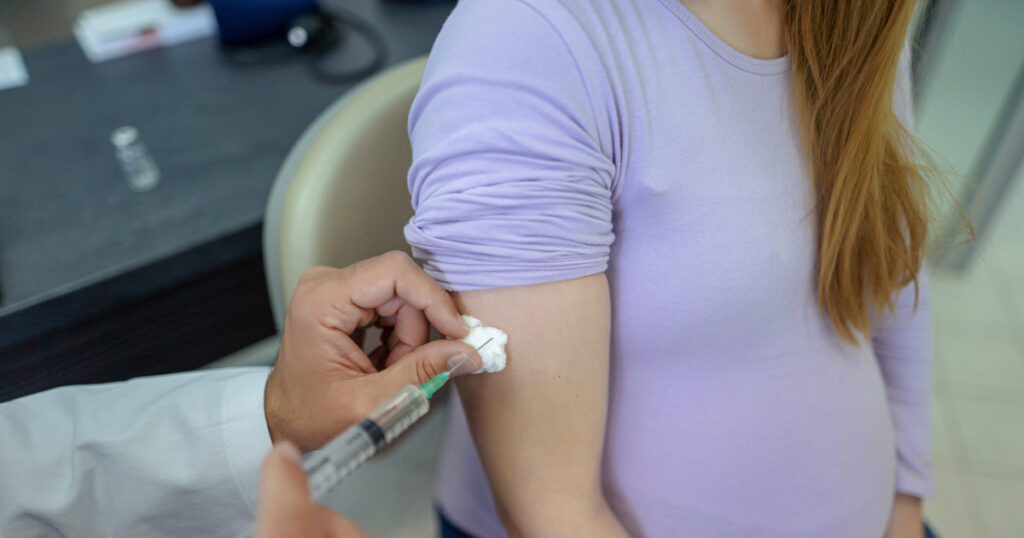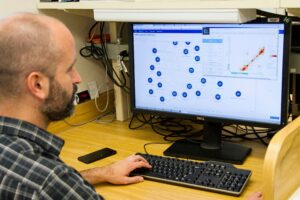
A pregnant young woman receives a vaccine at a preventive examination by a doctor
The launch of the national RSV Mother and Infant Protection Program (RSV-MIPP) in February marked a pivotal advancement in safeguarding newborns from severe respiratory illnesses. This initiative followed the earlier inclusion of the maternal respiratory syncytial virus (RSV) vaccine, Abrysvo, into the National Immunisation Program (NIP), a move celebrated as ‘world leading’. By April, funded immunisation programs for nirsevimab (marketed as Beyfortus), a long-acting monoclonal antibody for infants not covered by the maternal RSV vaccine, became accessible across all states and territories, including general practices.
Despite Australia’s leadership in this public health initiative, recent updates to maternal vaccination recommendations have led to confusion among healthcare providers. Professor Charlotte Hespe, Head of General Practice and Primary Care Research at the University of Notre Dame, highlights the need for clearer clinical education on maternal immunisation for healthcare professionals.
Challenges in Implementation and Understanding
Professor Hespe expressed gratitude for the RSV-MIPP, which provides free access to maternal RSV vaccines for pregnant women between 28–36 weeks gestation. However, she noted the fragmented rollout of the RSV program over the past 18 months, attributing it to the varied funding sources for vaccines across the country. “We just want to make sure that we’re on top of it in terms of safety,” she emphasized.
The coexistence of NIP and state health-funded programs, alongside guidance from the Australian Technical Advisory Group on Immunisation (ATAGI), has contributed to nationwide confusion. This is particularly pertinent in the post-COVID world, where RSV has emerged as a leading cause of hospitalisations among infants, transitioning from a historically under-discussed virus.
Complex Vaccine Landscape
Professor Hespe pointed out that three RSV vaccines have been developed, with two approved in Australia under the Therapeutic Goods Administration. “Understanding each of those vaccines, offering the right one, and proactively having those conversations with patients is incredibly powerful,” she stated.
Recent data reveals the number of babies hospitalised with RSV nearly halved in 2025 compared to the same time last year, thanks to the availability of the vaccine and monoclonal antibody.
Despite these positive outcomes, Professor Hespe supports calls for improved clarity regarding which vaccine or antibody product to prescribe for specific patient groups. In August, ATAGI issued a statement on RSV administration errors that triggered adverse events, which Professor Hespe described as “what you would expect to happen” given the lack of a unified rollout.
Need for Clear Communication and Education
The presence of three products—one for infants, one for pregnant women, and another for the elderly population—complicates the landscape. Professor Hespe highlighted the importance of clear communication, particularly the distinction between vaccines and monoclonal antibodies. “If we used different language and said ‘we’re giving the babies a monoclonal antibody protection’, it would show all health practitioners that it’s a completely different product,” she explained.
She also emphasized the need for proper storage and administration protocols. “If you stock it as a GP, you need to have it very clearly labelled that this is a monoclonal antibody—not the vaccine—and it’s for babies of this specific age group,” she advised. A system ensuring the correct product is administered to the correct patient is crucial.
The Role of General Practitioners
General practitioners play a vital role in communicating with patients about RSV vaccinations. “Pregnant women want to do everything they can to protect their babies, so understanding that getting the vaccine between 28–36 weeks gestation is highly protective against RSV for their babies,” Professor Hespe said.
She also urged GPs to encourage older patients to get vaccinated to reduce the virus’s circulation. “If you’re not already talking about it to your patients, do that, because if we can protect babies by ensuring fewer adults are sick, it’s beneficial,” she stated.
“Remember how important your recommendation is for our patients to actually do these vaccinations. Understanding each of those vaccines, offering the right one, and proactively having those conversations is incredibly powerful.”
As Australia continues to navigate the complexities of RSV vaccination, the emphasis remains on clear communication, education, and the proactive engagement of healthcare professionals to ensure the safety and health of the population.





